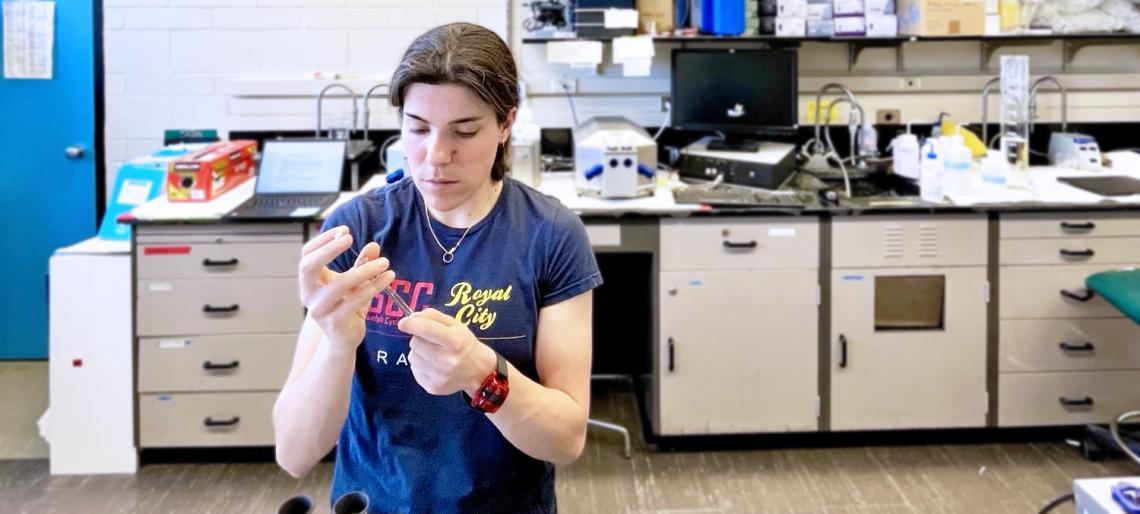Burning Questions: Why Your Muscles Prefer Carbs Over Fats During Intense Exercise

Mitochondria are the famous powerhouses of the cell, converting the carbohydrates and fats we eat into energy. But how do mitochondria decide whether to use fats versus carbohydrates from one moment to the next? It’s a question of “burning” importance when it comes to understanding human metabolism and athletic performance — and one that physiologists have spent decades studying.
During exercise, when your muscles need more energy, the use of both carbohydrates and fats increases to optimize energy production. However, since carbohydrates can be converted into energy faster, as exercise intensity increases, the cell prioritizes carbohydrates over fats.
While this switch from fats towards carbohydrates may seem simple on the surface, what actually drives this change is unclear. Since intense exercise creates a more acidic environment inside our working muscles, one potential explanation is that the shift in acidity could be a trigger.
Dr. Graham Holloway and PhD Candidate Sara Frangos from the Department of Human Health and Nutritional Sciences have shed light on this mystery. Their lab specializes in using mitochondrial respirometry, a technique that assesses how well mitochondria use different fuels to produce energy.
Tackling this question required a challenging, step-by-step process.
“We used several approaches to model the acidic environment that occurs in the muscle during exercise,” Frangos says. “There was a lot of time-consuming pilot work on the front end, balancing what would work experimentally versus what would reflect conditions in the muscle in real life.”
For the first approach, the researchers isolated individual mitochondria from mouse muscles. They then tested how well mitochondria could use fat for energy in neutral versus acidic conditions, focusing on an enzyme called CPT-I, which is the key control point for the ability of mitochondria to use fats.
In acidic conditions, Frangos and Holloway found two ways that the mitochondria’s ability to produce energy from fats was reduced. First, they saw reduced use of a molecule called L-carnitine, which helps transport fats into mitochondria through CPT-I. Second, they saw an enhanced ability of a molecule called malonyl-CoA to inhibit CPT-I.
However, they did this experiment in isolated mitochondria, completely isolated from other aspects of a muscle fibre. “There is much more architecture in whole muscle fibres,” Frangos says. “The effects we saw in isolated mitochondria could be changed by those extra structures.”
This led the researchers to go a step further, replicating the experiment in muscle fibre bundles. Remarkably, they observed the same mechanisms as before: reduced use of L-carnitine in producing energy, and enhanced inhibition from malonyl-CoA, still suggesting fat use is compromised in acidic conditions.
But they didn’t stop there. To confirm what happens in muscles after actual exercise, the researchers had mice complete an intense treadmill session, then immediately extracted muscle fibres from the mice and performed the same measurements.
Sure enough, the acidic environment still made it harder for mitochondria to use fat for energy following exercise. Across several methodologies, this clearly showed that the acidic environment in muscle greatly limits fat use by mitochondria.
One last question remained. The researchers also found that acidity reduced the use of carbohydrates by mitochondria, just like it did for fats. However, this was perplexing because it is well known that carbohydrate use increases during intense exercise despite acidic conditions.
So, what is it about exercise that allows mitochondria to continue to use carbohydrates?
Frangos explains that during exercise, there is an increase in the supply of breakdown products as the muscle contracts and mobilizes stored carbohydrates called glycogen. To mimic these conditions, the researchers increased the supply of these fuel sources in the acidic environment. After performing this extra step, mitochondria could effectively turn carbohydrates into energy, regardless of the acidity.
What does this complex series of findings mean overall? “In theory, if you’re fueled correctly, then you can compensate for the reduction in carbohydrate use due to the acidic pH during intense exercise,” Frangos explains. In other words, for optimal energy production during intense exercise, you need to ensure you’re providing your body with enough carbohydrates.
“By understanding these key mechanisms, we can use this knowledge in a more applied context,” Frangos says. “For example, we can identify molecular targets that can be leveraged as new strategies to maximize performance in elite sport.”
But for all the non-athletes out there just looking to get the most out of a hard gym session, make sure you’re fueling with enough carbohydrates beforehand!
This study was funded by the Natural Sciences and Engineering Research Council of Canada.
Read the full study in the Journal of Biological Chemistry.
Read about other CBS Research Highlights.